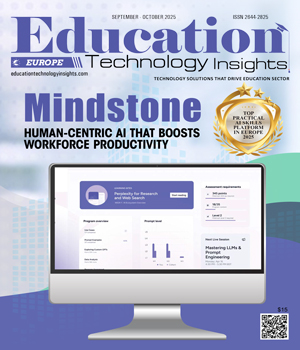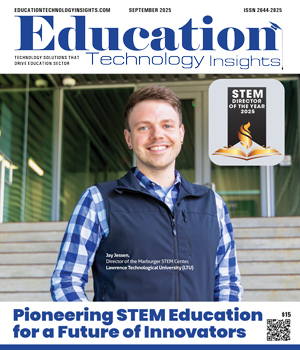THANK YOU FOR SUBSCRIBING
Be first to read the latest tech news, Industry Leader's Insights, and CIO interviews of medium and large enterprises exclusively from Education Technology Insights
Striving for Impactful and Sustainable Professional Learning
Anthony Dougherty, Director of Professional Development, The School District of Palm Beach County
 Anthony Dougherty, Director of Professional Development, The School District of Palm Beach County
Anthony Dougherty, Director of Professional Development, The School District of Palm Beach CountyAnthony Dougherty is the Director of Professional Development at the School District of Palm Beach County. He is passionate about helping educators thrive by creating professional learning experiences that educate, affirm, and inspire. As a director, he leads district-wide initiatives that strengthen educator readiness, support leadership growth, and build a sustainable system for professional learning.
Anthony's work spans teacher induction, onboarding, mentoring, employee evaluations, and cross-institutional partnerships. He shared his insights and valuable thoughts on the 2025 edition of Education Technology Insights, discussing the challenges in professional learning and the strategies for success.
In education, we devote a considerable amount of time and energy to planning lessons, designing engaging learning environments, and addressing the needs of the whole child. However, when it comes to professional learning for our own staff, we often skip many of these crucial pieces. We are often in such a rush to "get them trained" that we sometimes do so without considering that there is an art and science to how adults learn.
This is a disservice to our colleagues and education as a whole. In today's fast-paced world, where our attention is continually pulled in multiple directions, we must always think about how we approach professional learning. It's not enough to deliver information; we must foster learning that is authentic, engaging, and relevant to the participants.
Below are some of the most common challenges in professional learning, along with practical strategies to overcome them.
1. Time
In a world where we can literally spend hours scrolling through videos of road rage and home renovations gone wrong, the thought of sitting through a 15-minute compliance video is considered offensive. The digital world has set a new standard for what constitutes engaging content, and static slide decks alone are no longer hitting the mark. To respect your participants' time, keep content short, focused, and well-structured. Consider providing a variety of formats to accommodate different schedules and learning preferences. Offer options such as face-to-face sessions, self-paced online modules, peer discussions, and interactive simulations. When participants are presented with the choice of how they can learn, they are more likely to be engaged and receptive to the content.
2. Resources
You do not need a large budget to create high-quality professional learning experiences. Nearly 91% of U.S. adults own a smartphone, according to the Pew Research Centre, and those devices can record video, facilitate collaboration, and even deliver micro-learning.
If a prominent director like Steven Soderbergh can shoot an entire feature film (Unsane) on an iPhone, you can certainly create an engaging training video with your own device. The key is to maximize the resources available to you. Look for internal talent. Do you have an engaging and knowledgeable presenter? Give them the platform. A captivating presenter with a strong script, thoughtful approach, and authentic voice can deliver the engagement you seek. Just remember to run any new content by your legal, labor, and risk management teams to ensure there are no unforeseen concerns.
3. Relevance
Before you finalize any professional learning content, ask yourself: "Would I watch this? Would my spouse or friends find this interesting?" Professional learning must be relevant and practical to be effective. Put yourself in the shoes of your participants. If your content is intended for a diverse group (such as teachers, administrators, etc.) with varying roles and responsibilities, tailor the content to meet their specific needs. Use real-world scenarios that connect directly to the participants' daily work. If you're unsure about their current challenges, consider conducting surveys or holding informal conversations. Making learning relevant is one of the most effective ways to ensure retention.
4. Engagement
Too often, professional learning is viewed as just another meeting or task to add to your list. To combat this, find the early adopters who are eager to improve their practice and build your own "coalition of the willing." Clearly articulate why this learning is important, not just for the organization, but for their own professional growth. When people understand the value, they are much more likely to be engaged and invested in the learning.
5. Impact
The learning doesn't end when the session is over. It is crucial to think about how you will measure the impact of your professional learning. How will you know if the skills and knowledge were effectively delivered and retained? One-and-done professional learning with no follow-up is ineffective. Effective learning requires continued support. This can be as simple as a post-session survey, a peer discussion a few weeks later, or even a check-in email with additional resources. Follow-up reinforces the learning and shows your audience that their professional growth is a priority.
By shifting our perspective from "training" to "learning," we can design professional learning that is more effective and more valued and sought after. Let us apply the same care and intentionality to adult learning that we do to our students.
Read Also
Empowering Educators through Purposeful, Connected and Transformative Learning
Empowering Students to Lead: A New Vision for Civic Learning
The Director's Playbook: Strategic Digital Transformation in Rual Hyper-Growth Districts
The Art and Architecture of Student Support
From At-Risk to At-Promise: The Language Revolution Higher Education Needs
Teaching Tomorrow: How Western Governors University Is Redefining Teacher Preparation

I agree We use cookies on this website to enhance your user experience. By clicking any link on this page you are giving your consent for us to set cookies. More info

However, if you would like to share the information in this article, you may use the link below:
www.educationtechnologyinsightseurope.com/cxoinsights/anthony-dougherty-nid-3475.html





















